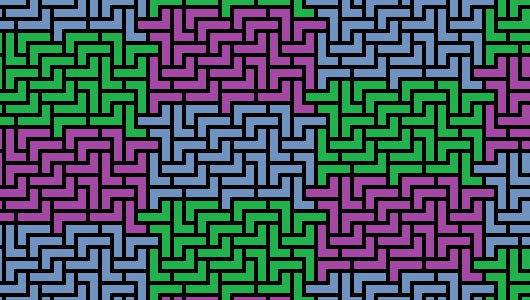I wonder if one can tile the plane with an order-$n$ L-polyomino in a fundamentally irregular manner. I seek help in defining what should constitute "irregular."
An L-polyomino of order $n \ge 2$ is a line of $n$ unit squares joined edge-to-edge, with one more square attached to the $n$-th to form an L-shape.
I am wondering for which $n$ is there an order-$n$ L-polyomino that can tile the plane "irregularly." Two regularities I would like to avoid are: (1) within the tiling any rectangle (of any size) tiled by L-polyominoes; see (a) in the figure below, using order-$4$ polyominoes. (2) any "periodic crack," which I define as an infinite staircase, with a finite periodic series of steps up/down and right/left, that never includes a point strictly interior to an L-polyomino. A simple example is in (b) below, but in general steps up and down, right and left, of varying length, would constitute a periodic crack if repeated infinitely. Such a periodic crack partitions the tiling into to "halves"; it is in some sense an infinite "digital line" cleaving the tiling in two halves.
Finally, (c) below shows a partial tiling by order-$4$ polyominoes
which (so far) violates neither (1) nor (2).

Q1. Is there an irregular tiling by L-polyominoes under my definition of "irregular"?
Q2. Are there accepted definitions of what constitutes an irregular tiling, by one tile (a monohedral tiling)?
(Addendum 1). To respond to Zack's question, let us insist that the tiles can only be rotated—no mirror reflections permitted. (This may be not be standard notation...)
(Addendum 2). The chair tiling (from this link),
as per Anthony Quas, with my superimposed periodic staircase:


